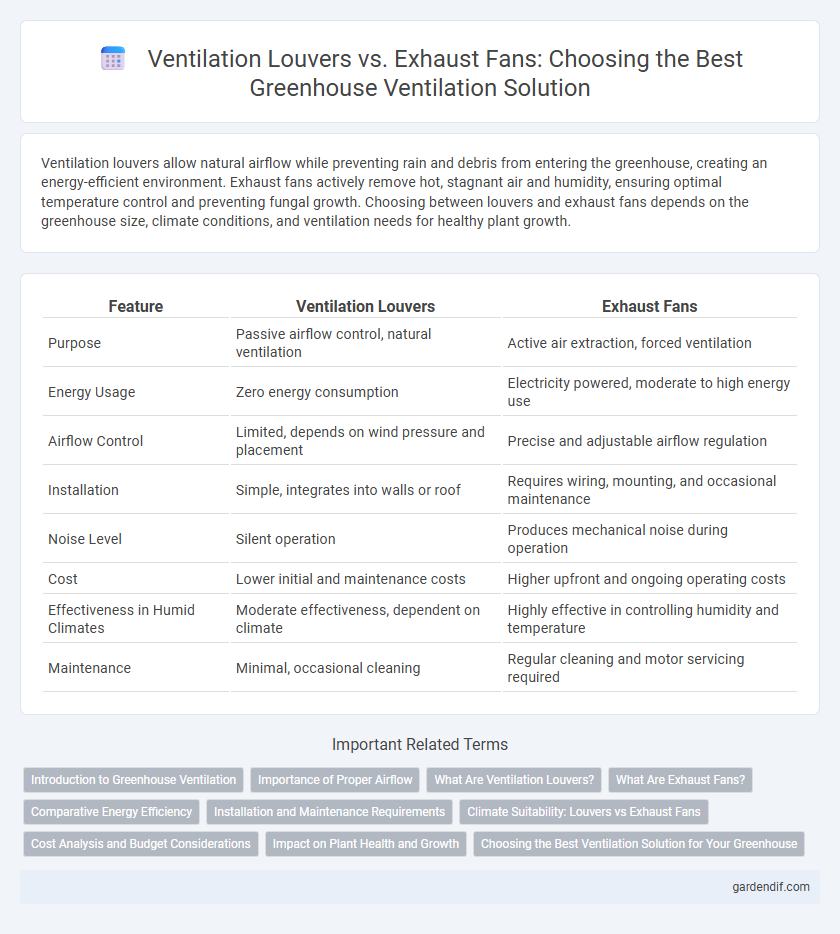
Ventilation Louvers vs Exhaust Fans Illustration
Ventilation louvers allow natural airflow while preventing rain and debris from entering the greenhouse, creating an energy-efficient environment. Exhaust fans actively remove hot, stagnant air and humidity, ensuring optimal temperature control and preventing fungal growth. Choosing between louvers and exhaust fans depends on the greenhouse size, climate conditions, and ventilation needs for healthy plant growth.
Table of Comparison
| Feature | Ventilation Louvers | Exhaust Fans |
|---|---|---|
| Purpose | Passive airflow control, natural ventilation | Active air extraction, forced ventilation |
| Energy Usage | Zero energy consumption | Electricity powered, moderate to high energy use |
| Airflow Control | Limited, depends on wind pressure and placement | Precise and adjustable airflow regulation |
| Installation | Simple, integrates into walls or roof | Requires wiring, mounting, and occasional maintenance |
| Noise Level | Silent operation | Produces mechanical noise during operation |
| Cost | Lower initial and maintenance costs | Higher upfront and ongoing operating costs |
| Effectiveness in Humid Climates | Moderate effectiveness, dependent on climate | Highly effective in controlling humidity and temperature |
| Maintenance | Minimal, occasional cleaning | Regular cleaning and motor servicing required |
Introduction to Greenhouse Ventilation
Ventilation louvers and exhaust fans are essential components in greenhouse ventilation, influencing airflow and temperature control to optimize plant growth. Louvers regulate natural air exchange by opening and closing to allow fresh air in, while exhaust fans actively remove hot, stale air, promoting a balanced environment. Selecting the appropriate ventilation system depends on greenhouse size, climate conditions, and specific crop requirements for maintaining optimal humidity and temperature levels.
Importance of Proper Airflow
Proper airflow in greenhouses is critical for maintaining optimal temperature, humidity, and CO2 levels, directly impacting plant health and growth. Ventilation louvers facilitate passive air exchange, reducing energy costs by allowing natural airflow, while exhaust fans actively remove hot, stale air to prevent heat stress and disease. Combining both systems ensures consistent air circulation, enhances climate control, and maximizes photosynthesis efficiency for higher crop yields.
What Are Ventilation Louvers?
Ventilation louvers are passive components installed in greenhouse walls to regulate airflow by allowing fresh air to enter while preventing rain and debris from entering. These louvers help maintain optimal temperature and humidity levels by facilitating continuous air exchange without consuming energy. Unlike exhaust fans, ventilation louvers operate silently and require no mechanical power, making them an energy-efficient solution for natural ventilation.
What Are Exhaust Fans?
Exhaust fans are mechanical devices designed to remove stale air, excess heat, and humidity from greenhouse environments, ensuring optimal airflow and climate control. These fans actively expel indoor air to the outside, preventing issues like mold growth and overheating that can negatively affect plant health. Compared to ventilation louvers that rely on passive air exchange, exhaust fans provide consistent and adjustable ventilation crucial for maintaining ideal growing conditions.
Comparative Energy Efficiency
Ventilation louvers rely on passive airflow to regulate greenhouse temperature, resulting in lower energy consumption compared to exhaust fans that use electricity to mechanically expel hot air. Exhaust fans provide more precise climate control but can significantly increase operational energy costs due to their continuous power demand. Optimizing greenhouse energy efficiency favors ventilation louvers for minimal energy use, while exhaust fans are ideal for environments requiring rapid and controlled air exchange.
Installation and Maintenance Requirements
Ventilation louvers require simple installation involving mounting on walls or roofs, with minimal structural adjustments, making them cost-effective and easy to integrate into existing greenhouse designs. Exhaust fans, however, demand more complex electrical wiring, precise positioning for airflow optimization, and regular maintenance such as motor lubrication and blade cleaning to ensure efficient operation. Both systems require periodic inspection, but louvers generally have lower maintenance demands compared to exhaust fans, which can experience mechanical wear over time.
Climate Suitability: Louvers vs Exhaust Fans
Ventilation louvers are ideal for mild climates where natural airflow can regulate temperature and humidity without excessive energy use, maximizing passive cooling. Exhaust fans perform better in hot, humid environments by actively expelling warm air and reducing moisture levels, ensuring optimal plant growth conditions. Selecting the system depends largely on climate factors such as temperature fluctuations and humidity control needs within the greenhouse.
Cost Analysis and Budget Considerations
Ventilation louvers typically involve lower upfront costs and minimal maintenance expenses, making them a budget-friendly option for passive airflow in greenhouses. Exhaust fans require higher initial investment and ongoing energy costs but provide more effective temperature and humidity control, which can lead to improved plant growth and potential yield increases. Careful cost analysis should weigh the long-term benefits of precise climate management against the immediate savings of simpler ventilation solutions.
Impact on Plant Health and Growth
Ventilation louvers provide passive airflow regulation that maintains stable humidity and temperature levels, crucial for optimal photosynthesis and disease prevention in greenhouse plants. Exhaust fans actively remove stale, hot air and increase air circulation, which helps reduce the risk of fungal infections and promotes stronger plant growth by enhancing CO2 availability. Combining both systems ensures a balanced environment that maximizes plant health and accelerates growth through effective air exchange and climate control.
Choosing the Best Ventilation Solution for Your Greenhouse
Ventilation louvers provide passive airflow control by allowing fresh air to enter the greenhouse while preventing debris and pests, optimizing natural ventilation for plant health and energy efficiency. Exhaust fans actively remove hot, stale air, enabling precise climate regulation and faster air exchange, essential for greenhouses in warmer climates or with high humidity levels. Selecting the best ventilation solution depends on factors such as greenhouse size, crop type, local climate, and energy consumption goals to ensure optimal growing conditions.
Ventilation Louvers vs Exhaust Fans Infographic

 gardendif.com
gardendif.com